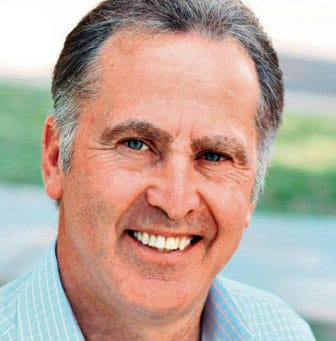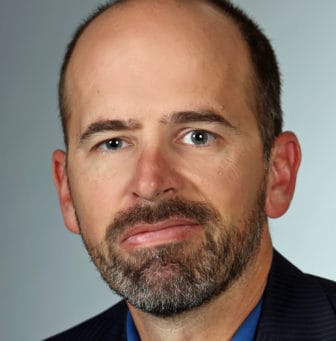Mudslinging has largely characterized this year’s Doña Ana County Democratic primary contest for district attorney.
But incumbent Mark D’Antonio’s attack on challenger James Dickens for changing parties from Republican to Democrat could just as easily stick to D’Antonio. He did the same thing a year before he first ran for DA in 2012.

Heath Haussamen / NMPolitics.net
The Third Judicial District Courthouse in Las Cruces.
And Dickens claims the Third Judicial District Attorney’s Office under D’Antonio’s watch is pleading out and dismissing too many cases. But the stats are complicated. Dickens and the DA’s Office have released dramatically different numbers they say came from the same case management system.
The reason for the discrepancy isn’t clear – and even if it was, interpreting the stats is somewhat subjective.
To further complicate things, there are ethical questions about how Dickens accessed stats.
Attacks aside, one notable fact that sets the candidates apart is Dickens’ massive fundraising lead. As of May 9 he had outraised D’Antonio nearly 4-1.
D’Antonio had collected just under $5,300, which included a $1,500 contribution from himself, as of May 9. His campaign filed his most recent report three days late, on May 12. That could result in a fine of $50 per day the report was late, should the Secretary of State’s Office choose to assess the fine.
Dickens, meanwhile, had raised just over $21,000, according to his most recent finance report – which was filed on time. Dickens’ donors include several people who worked in the DA’s office under previous Republican district attorneys Susana Martinez and Amy Orlando.
Dickens worked in the office during the tenures of both Republicans. He was chief deputy district attorney for Orlando, who Martinez appointed to replace her as district attorney when she became governor in 2011.
D’Antonio unseated Orlando a year later. Dickens left the office to become a prosecutor in the nearby 12th Judicial District based in Alamogordo.
Dickens credits his fundraising success not to his connections, but to his door-to-door campaigning and the poor job he says D’Antonio has done. “They know Mr. D’Antonio and they see how he’s running the office,” Dickens said. “So people are reaching to someone who has more experience.”
D’Antonio said fundraising won’t determine the outcome of the race. “Amy Orlando and the governor outspent me 3-1 last time,” D’Antonio said. “People know who’s right and who’s wrong. I have no fear; I’m working hard and have no doubt of the outcome.”
The fundraising appears to point to a difference between how the two candidates believe the DA’s Office should function. Central to Dickens’ campaign is the theme that D’Antonio isn’t winning enough cases – and some experienced former prosecutors are backing Dickens with their money. D’Antonio, on the other hand, says stats don’t account for his care for the people involved in each case – such as a victim who didn’t want to testify, which he says led his office to drop charges.
Dismissals and plea bargains
Dickens’ claims are based in part on statistics he compiled by accessing an internal database of case information from all state district attorney’s offices. He has access because of his job with the 12th Judicial DA’s Office. He says the numbers show that too many cases – 46 percent – didn’t lead to convictions or were pleaded out to lesser charges since D’Antonio took office on Jan. 1, 2013.
That includes cases the office declined to prosecute, that prosecutors dismissed after filing charges, that were dismissed by judges and juries, and in which some charges were dismissed as part of a plea bargain.

Courtesy photo
Mark D’Antonio
Dickens says he checked the internal numbers after hearing from law enforcement officers in Doña Ana County “that too many of their cases were declined or dismissed.” He also says a high number of plea bargains has resulted in less-severe sentences for defendants and fewer trials.
Dickens also cited statistics from the state Administrative Office of the Courts (AOC) – numbers that come from the courts themselves, not the prosecutors’ offices – that show in 2015 some 51 district court cases were resolved at trial in Doña Ana County. In the 12th District, meanwhile, Dickens said prosecutors took 72 cases to trial with fewer than half the attorneys working in D’Antonio’s office. And in the 5th District in Eastern New Mexico, which Dickens said has a similar number of attorneys to D’Antonio’s office, prosecutors took 191 cases to trial.
“It seems that the culture of the office is to avoid trial,” Dickens said. “…If you let the other party know that you are afraid to go forward, well then you’re going to settle the case with the smallest amount.”
Dickens’ claim doesn’t account for the particulars of individual cases, including what victims want, D’Antonio countered.
“[Dickens] doesn’t know that a victim on a case thanked me not to put her on the stand. Sometimes we make pleas because the victims don’t want to go to trial and are afraid of retaliation,” D’Antonio said. “Across the country 96 percent of cases are plead. Why? Because there is a certainty and finality in a plea.”

Courtesy photo
James Dickens
The AOC stats may point to a wider trend rather than an issue in D’Antonio’s office. While the number of cases dismissed by prosecutors rose dramatically in the Third District between the 2013 and 2014 fiscal years – from 442 to 1,176, according to an AOC report – similar jumps happened in some other judicial districts around the state – including the 12th, where Dickens works. There, dismissals rose from 178 to 407 during the same time period. In the Second District, which serves Bernalillo County, dismissals increased from 2,722 in 2013 to 4,769 in 2014.
But it’s difficult to compare stats. Measuring the AOC stats against how individual DA’s offices classify their cases can’t be accurately done, according to AOC spokesman Barry Massey and Patrick Hayes, spokesman for D’Antonio’s office.
One reason: There was a muddying of how cases were categorized internally in the DA’s Office when Orlando and Martinez were in charge, Hayes said. Before 2013, he said, some cases were recorded as having been declined for prosecution – without charges ever being filed by the DA’s office – when the cases had actually been accepted for prosecution and later dismissed.
The cases are recorded accurately today, Hayes said.
As if that wasn’t complicated enough, different sources are accessing the same case management system and coming up with different statistics. Dickens’ stats are based on analysis of about 7,000 cases throughout the entirety of D’Antonio’s tenure, while the Third District DA’s Office released stats to NMPolitics.net in response to a records request that include more than 18,000 cases. Dickens suggested the DA’s Office might be counting individual charges, rather than cases that could include multiple charges, but the DA’s Office says that isn’t the case.
The reason for the discrepancy isn’t clear.
Interestingly, if you apply Dickens’ method of interpreting the stats to the numbers released by the DA’s Office, you get an even higher percentage of cases that didn’t lead to convictions or were pleaded out – 61 percent.
And, in the world of subjective interpretation, there are questions about Dickens’ explanation of the numbers. He adds together cases that didn’t lead to convictions with plea bargains to get to his 46 percent claim – but plea bargains are convictions, even if on lesser charges.
Dickens defended lumping plea bargains in with cases that didn’t lead to convictions, saying too often a plea bargain means a prosecutor dropped serious charges simply to close a case and mark it as a conviction. The most serious charges represent crimes that were “the most detrimental to the victim, the most detrimental to the community,” he said.
Questions about how Dickens accessed stats
Dickens released an extensive spreadsheet to NMPolitics.net detailing case resolutions he says support his claim about 46 percent under D’Antonio’s watch not leading to convictions or being pleaded out. Dickens has come under fire for how he accessed those numbers.
D’Antonio, in a May 5, 2016 letter to 12th Judicial District Attorney David Ceballes, Dickens’ boss, accused Dickens of “inappropriate access to privileged information.” Dickens accessed the information in his capacity as a prosecutor and is using it to further his political campaign, which D’Antonio alleged might be illegal.
Dickens said the information is public record and he is confident he did nothing wrong. And he accused D’Antonio of attacking a whistleblower who is exposing “his office’s abysmal record.”
“This is the typical bureaucrat’s tactic when their malfeasance has been laid bare to public scrutiny,” Dickens said.
D’Antonio accused Dickens of accessing the information using his government-owned computer during work hours — which Dickens told NMPolitics.net he “categorically” denies. Dickens accused D’Antonio of directing “his own, publicly funded, District Attorney investigators to review the matter” and called that an “ethical dilemma.”
Henry Valdez, director of the state’s Administrative Office of the District Attorneys (AODA), which maintains the case management system, wouldn’t comment on the ethics of a prosecutor accessing the system to compile statistics for campaign purposes. But he explained that the system was implemented with public money to help district attorneys and some other law enforcement agencies share information between jurisdictions. That’s especially important when an agency is trying to determine whether a defendant has criminal cases in another part of the state.
Information in the case management system is also used for the state’s victim notification system – which lets people sign up to receive text messages when a case’s status changes.
Some of the information in the system is public record, but some – like internal district attorney files for active cases, or information about mental commitments or other medical information – may not be public, Valdez said.
Switched parties – and changes of heart?
The fight over statistics – what they mean and how they were obtained – isn’t the only battle dragging this contest into the mud. In the Democratic primary, D’Antonio wants voters to believe Dickens isn’t a real Democrat.
“He’s a good prosecutor, but [the party change] shows that he’s willing to do anything it takes to get elected,” D’Antonio said. The accusation is part of D’Antonio’s efforts to tie Dickens to his political nemeses – Martinez and Orlando.
But switching parties from Republican to Democrat is something D’Antonio also did.
Dickens, whose switch came three years before campaigning for DA, in March 2013, said his son’s diagnosis of autism and his family’s search for help led to an ideological shift.
“When I see politicians play political football with the health-care system, with access to mental health, I get a cold sweat thinking of what would have happened to my son had we not had access to all of resources we had at the time,” Dickens said. “It opened my eyes to the idea that we’re not just self-made people. We’re a part of a community.”
D’Antonio said his party change, which came in March 2011, a year before he filed to run for DA, was sincere.
“I truly am a liberal and have proved it ever since I have been here – and I’ve fought Susana Martinez more than anyone else in the other part of the state,” D’Antonio said.
Dickens urged voters to compare the situations.
“He switched from Republican to Democrat in March of 2011 and was collecting signatures in his bid for election before the end of that year,” Dickens wrote in a statement to the media. “Now I do not know if his switch was as cynical a political ploy as it appears, or a genuine perspective change. Frankly, I do not care.”
Whatever the case, the winner of the June 7 Democratic primary will face a candidate who is currently registered as a Republican – Brad Cates, a former state and federal prosecutor and state representative – in November. Cates is dealing with his own controversy over images that were posted on a personal website.
Heath Haussamen contributed to this report.